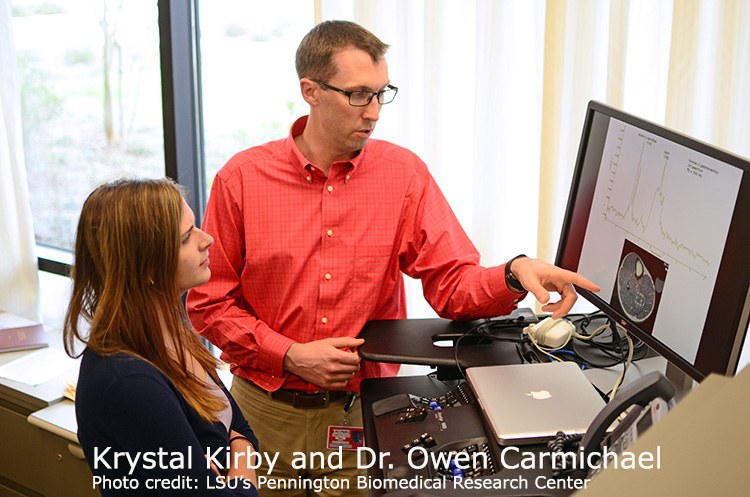Kirby Awarded Economic Development Assistantship to Study iMQC MRI to Help Detect Brain Tumors and Fight Obesity
Krystal Kirby, a third-year PhD student working under Dr. Owen Carmichael at LSU’s Pennington Biomedical Research Center, has been awarded an Economic Development Assistantship by the LSU Graduate School. Kirby is enrolled in the medical physics program in the Department of Physics & Astronomy, and is currently performing her research at the Pennington Biomedical’s Imaging Facility, which was opened in 2014.
 Nearly 78,000 new cases of brain cancer were diagnosed in 2015, with a fatality rate
of about 20 percent. Earlier detection of these tumors would significantly increase
the survival rate for these patients because they could receive treatment before the
cancer becomes untreatable. Magnetic resonance imaging (MRI) is a safe, widely available,
noninvasive medical procedure that is used to detect cancer elsewhere in the body,
but MRI provides relatively poor contrast between tumors and surrounding normal brain
tissue, making early detection of small brain tumors difficult.
Nearly 78,000 new cases of brain cancer were diagnosed in 2015, with a fatality rate
of about 20 percent. Earlier detection of these tumors would significantly increase
the survival rate for these patients because they could receive treatment before the
cancer becomes untreatable. Magnetic resonance imaging (MRI) is a safe, widely available,
noninvasive medical procedure that is used to detect cancer elsewhere in the body,
but MRI provides relatively poor contrast between tumors and surrounding normal brain
tissue, making early detection of small brain tumors difficult.
In addition, our obesity epidemic continues to damage the health of tens of millions of Americans, and effective ways to maintain weight loss over the long term have been elusive. Making our body fat burn more calories is one promising approach to maintaining weight loss, but it has been difficult to identify the brown fat—the “good fat” that burns calories at a high rate—using medical tests that don’t involve an injection, infusion, or taking tissue out of the body. An MRI test for brown fat could help researchers develop and test new therapies that make this tissue burn more calories.
The award will provide support for Kirby to study intermolecular multiple quantum coherence (iMQC) MRI. This is an emerging type of MRI that can significantly enhance both tumor contrast and the contrast between brown fat and other tissues. The primary goal of her project is to develop iMQC into a clinically feasible technique that is positioned to help both radiation oncologists detect brain tumors and obesity researchers assess new obesity treatments.
Quantum coherence imaging hasn’t been used in a clinical setting before, but teaming up with Pennington Biomedical means Kirby’s work to develop the technology could benefit health in a variety of arenas.
In her new role, Kirby will work to develop and characterize a new and unique iMQC MRI pulse sequence, then optimize data collection, reduce image artifacts, and minimize image acquisition time to make the pulse sequence clinically acceptable. Most of her time will be spent at Pennington Biomedical, which boasts two 3T MRI machines suitable for her project. Her hope is to collaboratively develop the technology, secure patents, and license the technology to commercial MRI machine manufacturers, as well as treatment planning systems that utilize MR images for cancer patients.
The LSU medical physics program is run in partnership with Mary Bird Perkins Cancer Center, a private not-for-profit cancer center in Baton Rouge.